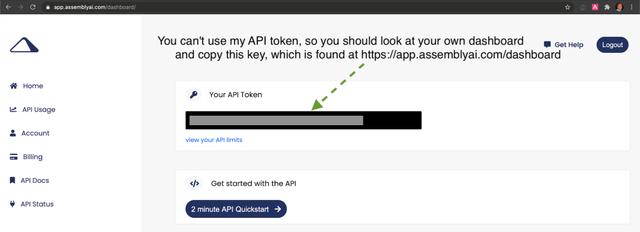您好,登錄后才能下訂單哦!
您好,登錄后才能下訂單哦!
這篇文章將為大家詳細講解有關Python中怎么自動化語音轉文本,文章內容質量較高,因此小編分享給大家做個參考,希望大家閱讀完這篇文章后對相關知識有一定的了解。
搭建開發環境
轉到保存Python虛擬環境的目錄。我將我的目錄保存在用戶主目錄下的venvs子目錄中。使用以下命令為此項目創建一個新的virtualenv。
python3 -m venv ~/venvs/pytranscribe
用 shell 命令激活 virtualenv:
source ~/venvs/pytranscribe/bin/activate
執行上述命令后,命令提示符將發生更改,因此virtualenv的名稱將以原始命令提示符格式開頭,如果您的提示符只是$,則其外觀如下所示:
(pytranscribe) $
請記住,您必須在每個 virtualenv 中使用依賴項的新終端窗口中激活您的 virtualenv 。
現在,我們可以將請求包安裝到已激活但為空的 virtualenv 中。
pip install requests==2.24.0
查找類似于以下內容的輸出,以確認從PyPI正確安裝了相應的軟件包。
(pytranscribe) $ pip install requests==2.24.0 Collecting requests==2.24.0 Using cached https://files.pythonhosted.org/packages/45/1e/0c169c6a5381e241ba7404532c16a21d86ab872c9bed8bdcd4c423954103/requests-2.24.0-py2.py3-none-any.whl Collecting certifi>=2017.4.17 (from requests==2.24.0) Using cached https://files.pythonhosted.org/packages/5e/c4/6c4fe722df5343c33226f0b4e0bb042e4dc13483228b4718baf286f86d87/certifi-2020.6.20-py2.py3-none-any.whl Collecting urllib3!=1.25.0,!=1.25.1,<1.26,>=1.21.1 (from requests==2.24.0) Using cached https://files.pythonhosted.org/packages/9f/f0/a391d1463ebb1b233795cabfc0ef38d3db4442339de68f847026199e69d7/urllib3-1.25.10-py2.py3-none-any.whl Collecting chardet<4,>=3.0.2 (from requests==2.24.0) Using cached https://files.pythonhosted.org/packages/bc/a9/01ffebfb562e4274b6487b4bb1ddec7ca55ec7510b22e4c51f14098443b8/chardet-3.0.4-py2.py3-none-any.whl Collecting idna<3,>=2.5 (from requests==2.24.0) Using cached https://files.pythonhosted.org/packages/a2/38/928ddce2273eaa564f6f50de919327bf3a00f091b5baba8dfa9460f3a8a8/idna-2.10-py2.py3-none-any.whl Installing collected packages: certifi, urllib3, chardet, idna, requests Successfully installed certifi-2020.6.20 chardet-3.0.4 idna-2.10 requests-2.24.0 urllib3-1.25.10
我們已經安裝了所有必需的依賴項,因此我們可以開始對應用程序進行編碼。
上傳、啟動和轉錄音頻
我們已完成開始構建應用程序所需的一切,該應用程序會將音頻轉換為文本。我們將在三個文件中構建此應用程序:
1、upload_audio_file.py:將您的音頻文件上傳到AssemblyAI服務上的安全位置,以便可以進行處理。如果您的音頻文件已經可以通過公共URL訪問,則無需執行此步驟,只需按照此快速入門(https://docs.assemblyai.com/overview/getting-started)
2、initial_transcription.py:告訴API要轉錄并立即啟動的文件
3、get_transcription.py:如果仍在處理轉錄,則顯示轉錄狀態,或者在處理完成后顯示轉錄結果
創建一個名為pytranscribe的新目錄,以在我們編寫文件時存儲這些文件。然后轉到新的項目目錄。
mkdir pytranscibe cd pytranscribe
我們還需要將 AssemblyAI API 密鑰導出為環境變量。注冊 AssemblyAI 賬戶并登錄 AssemblyAI 儀表板,然后復制“您的API token”,如以下屏幕截圖所示:

export ASSEMBLYAI_KEY=your-api-key-here
請注意,必須每個命令行窗口中使用 export 命令以保證此密鑰可訪問。如果您沒有在運行腳本的環境中將標記導出為 ASSEMBLYAI_KEY,則我們正在編寫的腳本將無法訪問API。
現在我們已經創建了項目目錄并將API密鑰設置為環境變量,讓我們繼續編寫第一個文件的代碼,該文件會將音頻文件上傳到AssemblyAI服務。
上傳音頻文件并進行轉錄
創建一個名為upload_audio_file.py的新文件,并將以下代碼放入其中:
import argparse
import os
import requests
API_URL = "https://api.assemblyai.com/v2/"
def upload_file_to_api(filename):
"""Checks for a valid file and then uploads it to AssemblyAI
so it can be saved to a secure URL that only that service can access.
When the upload is complete we can then initiate the transcription
API call.
Returns the API JSON if successful, or None if file does not exist.
"""
if not os.path.exists(filename):
return None
def read_file(filename, chunk_size=5242880):
with open(filename, 'rb') as _file:
while True:
data = _file.read(chunk_size)
if not data:
break
yield data
headers = {'authorization': os.getenv("ASSEMBLYAI_KEY")}
response = requests.post("".join([API_URL, "upload"]), headers=headers,
data=read_file(filename))
return response.json()上面的代碼導入了argparse,os和request軟件包,以便我們可以在此腳本中使用它們。API_URL是一個常量,具有AssemblyAI服務的基本URL。我們使用單個參數定義upload_file_to_api函數,filename應該是一個字符串,其中包含文件及其文件名的絕對路徑。
在函數中,我們檢查文件是否存在,然后使用Request的分塊傳輸編碼將大文件流式傳輸到AssemblyAI API。
os模塊的getenv函數讀取使用帶有getenv的export命令在命令行上設置的API。確保在運行此腳本的終端中使用該導出命令,否則ASSEMBLYAI_KEY值將為空白。如有疑問,請使用echo $ ASSEMBLY_AI查看該值是否與您的API密鑰匹配。
要使用upload_file_to_api函數,請將以下代碼行添加到upload_audio_file.py文件中,以便我們可以正確地將此代碼作為使用python命令調用的腳本執行:
if __name__ == "__main__":
parser = argparse.ArgumentParser()
parser.add_argument("filename")
args = parser.parse_args()
upload_filename = args.filename
response_json = upload_file_to_api(upload_filename)
if not response_json:
print("file does not exist")
else:
print("File uploaded to URL: {}".format(response_json['upload_url']))上面的代碼創建了一個ArgumentParser對象,它允許應用程序從命令行獲取單個參數來指定我們要訪問的對象,讀取并上傳到AssmeblyAI服務的文件。
如果文件不存在,腳本將顯示一條消息,提示找不到該文件。在路徑中,我們確實找到了正確的文件,然后使用upload_file_to_api函數中的代碼上傳了文件。
通過使用python命令在命令行上運行完整的upload_audio_file.py腳本,以執行該腳本。將FULL_PATH_TO_FILE替換為您要上傳的文件的絕對路徑,例如/Users/matt/devel/audio.mp3。
python upload_audio_file.py FULL_PATH_TO_FILE
假設在您指定的位置找到文件,當腳本完成文件的上傳后,它將打印一條帶有唯一URL的消息:
File uploaded to URL: https://cdn.assemblyai.com/upload/463ce27f-0922-4ea9-9ce4-3353d84b5638
該URL不是公開的,只能由AssemblyAI服務使用,因此除您及其轉錄的API外,其他任何人都無法訪問您的文件及其內容。
重要的部分是URL的最后一部分,在此示例中為463ce27f-0922-4ea9-9ce4-3353d84b5638。保存該唯一標識符,因為我們需要將其傳遞給下一個啟動轉錄服務的腳本。
啟動轉錄
接下來,我們將編寫一些代碼來開始轉錄。創建一個名為initial_transcription.py的新文件。將以下代碼添加到新文件中。
import argparse
import os
import requests
API_URL = "https://api.assemblyai.com/v2/"
CDN_URL = "https://cdn.assemblyai.com/"
def initiate_transcription(file_id):
"""Sends a request to the API to transcribe a specific
file that was previously uploaded to the API. This will
not immediately return the transcription because it takes
a moment for the service to analyze and perform the
transcription, so there is a different function to retrieve
the results.
"""
endpoint = "".join([API_URL, "transcript"])
json = {"audio_url": "".join([CDN_URL, "upload/{}".format(file_id)])}
headers = {
"authorization": os.getenv("ASSEMBLYAI_KEY"),
"content-type": "application/json"
}
response = requests.post(endpoint, json=json, headers=headers)
return response.json()我們具有與先前腳本相同的導入,并添加了一個新常量CDN_URL,該常量與AssemblyAI存儲上傳的音頻文件的單獨URL匹配。
initiate_transcription函數本質上只是向AssemblyAI API設置了一個HTTP請求,以傳入的特定URL對音頻文件啟動轉錄過程。這就是為什么file_id傳遞很重要的原因:完成音頻文件的URL 我們告訴AssemblyAI進行檢索。
通過附加此代碼來完成文件,以便可以從命令行輕松地使用參數調用它。
if __name__ == "__main__":
parser = argparse.ArgumentParser()
parser.add_argument("file_id")
args = parser.parse_args()
file_id = args.file_id
response_json = initiate_transcription(file_id)
print(response_json)通過在initiate_transcription文件上運行python命令來啟動腳本,并傳入您在上一步中保存的唯一文件標識符。
# the FILE_IDENTIFIER is returned in the previous step and will # look something like this: 463ce27f-0922-4ea9-9ce4-3353d84b5638 python initiate_transcription.py FILE_IDENTIFIER
API將發回該腳本打印到命令行的JSON響應。
{'audio_end_at': None, 'acoustic_model': 'assemblyai_default', 'text': None,
'audio_url': 'https://cdn.assemblyai.com/upload/463ce27f-0922-4ea9-9ce4-3353d84b5638',
'speed_boost': False, 'language_model': 'assemblyai_default', 'redact_pii': False,
'confidence': None, 'webhook_status_code': None,
'id': 'gkuu2krb1-8c7f-4fe3-bb69-6b14a2cac067', 'status': 'queued', 'boost_param': None,
'words': None, 'format_text': True, 'webhook_url': None, 'punctuate': True,
'utterances': None, 'audio_duration': None, 'auto_highlights': False,
'word_boost': [], 'dual_channel': None, 'audio_start_from': None}記下JSON響應中id鍵的值。這是我們需要用來檢索轉錄結果的轉錄標識符。在此示例中,它是gkuu2krb1-8c7f-4fe3-bb69-6b14a2cac067。復制轉錄標識符到您自己的響應中,因為在下一步中我們將需要它來檢查轉錄過程何時完成。
檢索轉錄結果
我們已經上傳并開始了轉錄過程,因此,準備就緒后,我們將盡快獲得結果。
返回結果所需的時間取決于文件的大小,因此下一個腳本將向HTTP發送一個HTTP請求,并報告轉錄狀態,或者在完成后打印輸出。
創建一個名為 get_transcription.py 的第三個Python文件,并將以下代碼放入其中。
import argparse
import os
import requests
API_URL = "https://api.assemblyai.com/v2/"
def get_transcription(transcription_id):
"""Requests the transcription from the API and returns the JSON
response."""
endpoint = "".join([API_URL, "transcript/{}".format(transcription_id)])
headers = {"authorization": os.getenv('ASSEMBLYAI_KEY')}
response = requests.get(endpoint, headers=headers)
return response.json()
if __name__ == "__main__":
parser = argparse.ArgumentParser()
parser.add_argument("transcription_id")
args = parser.parse_args()
transcription_id = args.transcription_id
response_json = get_transcription(transcription_id)
if response_json['status'] == "completed":
for word in response_json['words']:
print(word['text'], end=" ")
else:
print("current status of transcription request: {}".format(
response_json['status']))上面的代碼與其他腳本具有相同的 imports 對象。在這個新的get_transcription函數中,我們只需使用我們的API密鑰和上一步中的轉錄標識符(而不是文件標識符)調用AssemblyAI API。我們檢索JSON響應并將其返回。
在main函數中,我們處理作為命令行參數傳入的轉錄標識符,并將其傳遞給get_transcription函數。如果來自get_transcription函數的響應JSON包含completed狀態,則我們將打印轉錄結果。否則,請在completed之前打印當前狀態如queued或processing。
使用命令行和上一節中的轉錄標識符調用腳本:
python get_transcription.py TRANSCRIPTION_ID
如果該服務尚未開始處理腳本,則它將返回queued,如下所示:
current status of transcription request: queued
當服務當前正在處理音頻文件時,它將返回processing:
current status of transcription request: processing
該過程完成后,我們的腳本將返回轉錄文本,如您在此處看到的那樣:
An object relational mapper is a code library that automates the transfer of data stored in relational, databases into objects that are more commonly used in application code or EMS are useful because they provide a high level ...(output abbreviated)
關于Python中怎么自動化語音轉文本就分享到這里了,希望以上內容可以對大家有一定的幫助,可以學到更多知識。如果覺得文章不錯,可以把它分享出去讓更多的人看到。
免責聲明:本站發布的內容(圖片、視頻和文字)以原創、轉載和分享為主,文章觀點不代表本網站立場,如果涉及侵權請聯系站長郵箱:is@yisu.com進行舉報,并提供相關證據,一經查實,將立刻刪除涉嫌侵權內容。